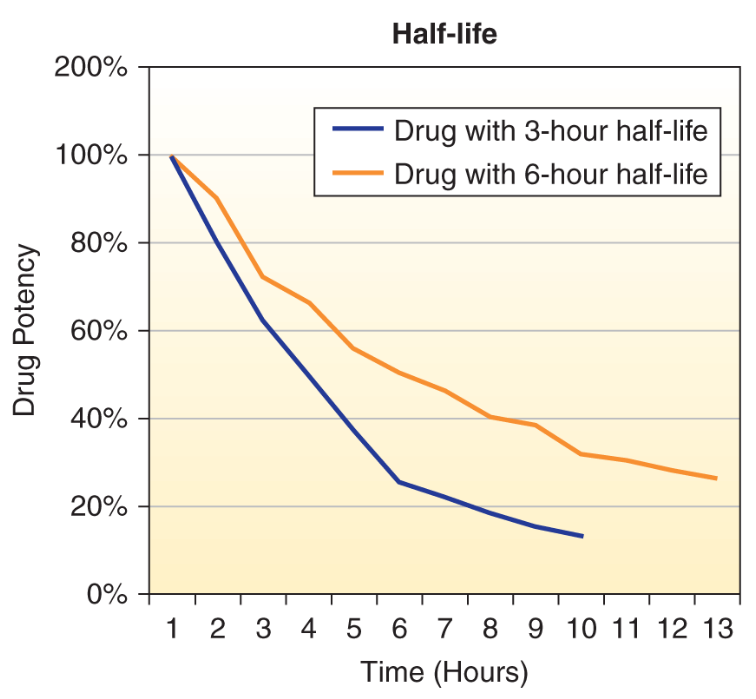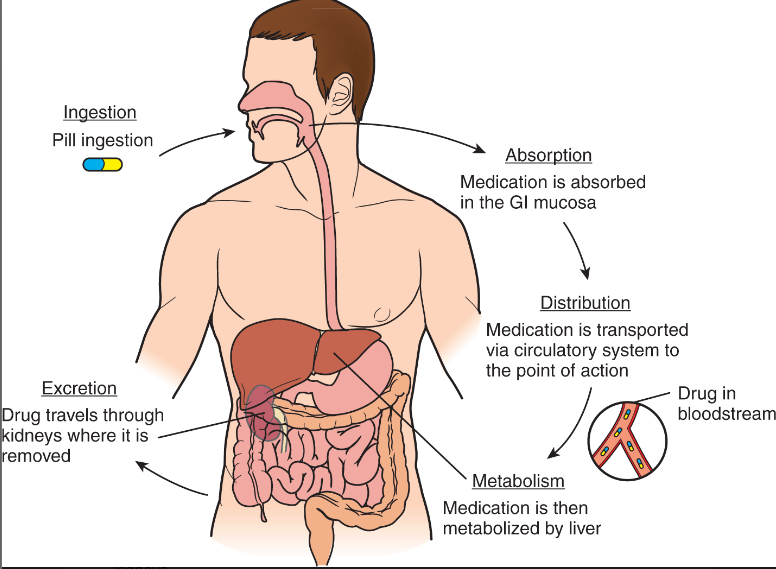CH 2 - Basics of Pharmacology (Watkins)
1/24
There's no tags or description
Looks like no tags are added yet.
Name | Mastery | Learn | Test | Matching | Spaced |
|---|
No study sessions yet.
25 Terms
Absorption
is the process by which a substance moves into the bloodstream from the site where it was administered. A drug can be administered in one of two ways: (1) enterally, which means the drug is given directly into the gastrointestinal (GI) system orally, rectally, or through a tube entering this system; or (2) parenterally, by all other routes that do not touch the GI system.
medication is absorption depends on how it is administered and whether it is topical (act locally) or systemic (act on one or more body systems)
Adverse reaction
is a severe side effect that can cause severe harm or death, such as hallucinations, hypotension, or anaphylactic shock. An example is airway swelling.
Agonist
when it is taken with another drug so the two can work together
Antagonist
drugs do the opposite by rendering another drug less effective.
Bioavailability
how much of the drug is absorbed for use
Biotransformation or Metabolism
means that the medication is chemically transformed to a less active or inactive form, called a metabolite.
The liver (does most of the work), kidneys, and intestines metabolize drugs
distribution
The second phase in the drug cycle is ____________, which is the delivery of a drug to the appropriate site after the drug has been absorbed into the bloodstream.
well-perfused organs such as the brain, heart, kidneys, and lungs receive the majority of the medication.
excretion
occurs when the extra medication and waste products are eliminated from the body. This process occurs mainly through the kidneys. ensures that drugs and their transformed products are removed and do not build up in the body (called cumulation). If buildup occurs, the patient may become very ill.
half-life
A medication’s ______________ is the length of time required for its concentration to decrease by one-half in the blood plasma and therefore affects its duration of potency.

idiosyncratic
a unique reaction to any drug
may not have occurred in clinical trials because it is so rare
pharmacokinetics
study of how the body absorbs, distributes, and excretes drugs (the drug cycle)
receptors
All cells have numerous receptors that are activated or blocked by messengers to produce an effect. Think of a receptor as a lock and the messenger—in this case the medication—a key.
side effects
are usually mild, such as nausea, constipation, or sensitivity to light.
synergism
occurs when a drug combination provides a more potent effect than when each drug is taken separately
teratogenic
interferes with normal fetal development
toxic
too much can be _______ , or poisonous, to the patient.
The Drug Cycle
This cycle has four main phases:
absorption (how the medication enters our bloodstream)
distribution (how the medication travels to the appropriate site)
metabolism or biotransformation (how our body breaks the medication down into usable components and waste products)
excretion (how our body eliminates the extra medication and waste products)

Factors that may vary the absorption rate
fat or lipid solubility
pH
Concentration of the medication
length of contact
age
food
depth of breathing
factors influencing the time it takes to complete the drug cycle
therapeutic level
potency
interactions w/ other medicine
route of administration
health of the patients organs
specialized physiological “barriers”
densely packed cells that allow nutrients and certain chemicals, but not other substances, including medications, to pass from the blood through the tissue.
Examples of these densely packed cells include the blood-brain barrier, the blood-testicular barrier, and the blood-placental barrier.
ototoxicity
result of hearing loss or balance
USP/NF
official source of medication information for drugs approved by the U.S.
has two volumes; the first is written primarily for the prescriber, and the second is written in lay terms to make it easy for patients to understand.
Food and Drug Administration (FDA)
It is updated every 5 years, with frequent supplements. This publication provides standards for identification, quality, strength, and purity of substances
Physicians’ Desk Reference (PDR)
This text contains information about thousands of drugs and is indexed by trade name, generic name, classification, and manufacturer. Color photographs of most common drugs are included to help identify medications when patients are unsure about what they are taking.
Therapeutic level
refers to the point at which the drug has the optimum desired effect. Too little of the drug can be less than effective; too much can be toxic, or poisonous. Drugs are usually administered at the lowest dose possible to obtain therapeutic levels.